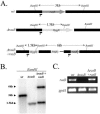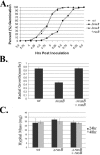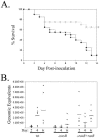A fungus-specific ras homolog contributes to the hyphal growth and virulence of Aspergillus fumigatus
- PMID: 16339716
- PMCID: PMC1317486
- DOI: 10.1128/EC.4.12.1982-1989.2005
A fungus-specific ras homolog contributes to the hyphal growth and virulence of Aspergillus fumigatus
Erratum in
- Eukaryot Cell. 2007 Jan;6(1):117
Abstract
The Ras family of GTPase proteins has been shown to control morphogenesis in many organisms, including several species of pathogenic fungi. In a previous study, we identified a gene encoding a fungus-specific Ras subfamily homolog, rasB, in Aspergillus fumigatus. Here we report that deletion of A. fumigatus rasB caused decreased germination and growth rates on solid media but had no effect on total biomass accumulation after 24 h of growth in liquid culture. The DeltarasB mutant had an irregular hyphal morphology characterized by increased branching. Expression of rasBDelta113-135, a mutant transgene lacking the conserved rasB internal amino acid insertion, did not complement the deletion phenotype of delayed growth and germination rates and abnormal hyphal morphology. Virulence of the rasB deletion strain was diminished; mice infected with this strain exhibited approximately 65% survival compared to approximately 10% with wild-type and reconstituted strains. These data support the hypothesis that rasB homologs, which are highly conserved among fungi that undergo hyphal growth, control signaling modules important to the directional growth of fungal hyphae.
Figures








References
-
- Alspaugh, J. A., L. M. Cavallo, J. R. Perfect, and J. Heitman. 2000. RAS1 regulates filamentation, mating and growth at high temperature of Cryptococcus neoformans. Mol. Microbiol. 36:352-365. - PubMed
-
- Cove, D. 1966. The induction and repression of nitrate reductase in the fungus Aspergillus nidulans. Biochim. Biophys. Acta 113:5-56. - PubMed
Publication types
MeSH terms
Substances
Grants and funding
LinkOut - more resources
Full Text Sources
Molecular Biology Databases

